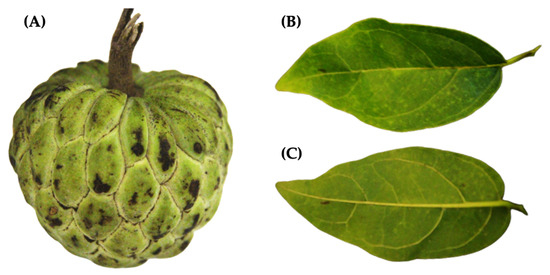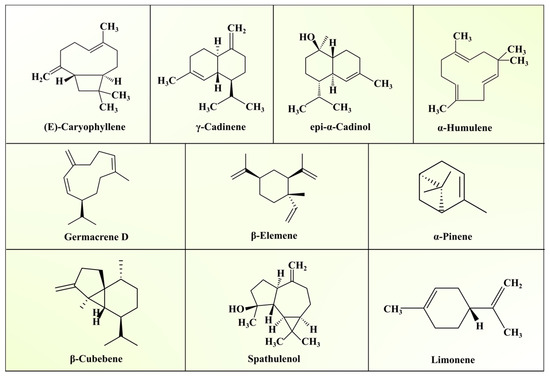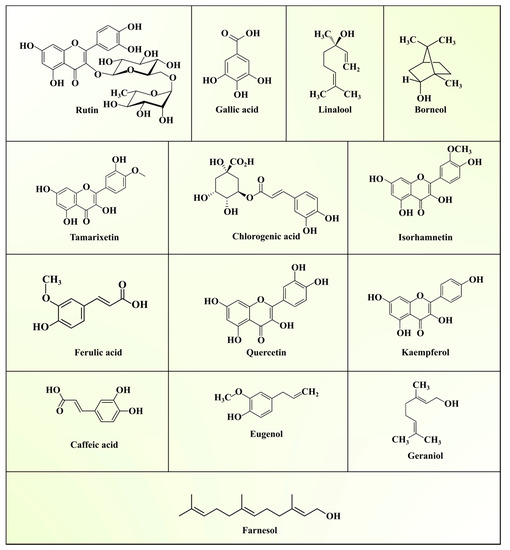Annona squamosa L. (custard apple) belongs to the family Annonaceae and is an important tropical fruit cultivated in the West Indies, South and Central America, Ecuador, Peru, Brazil, India, Mexico, the Bahamas, Bermuda, and Egypt. Leaves of custard apple plants have been studied for their health benefits, which are attributed to a considerable diversity of phytochemicals. These compounds include phenol-based compounds, e.g., proanthocyanidins, comprising 18 different phenolic compounds, mainly alkaloids and flavonoids. Extracts from Annona squamosa leaves (ASLs) have been studied for their biological activities, including anticancer, antidiabetic, antioxidant, antimicrobial, antiobesity, lipid-lowering, and hepatoprotective functions.
- custard apple leaves
- biological activities
- phenolic bioactives
1. Annona Squamosa L. (Annonaceae)

2. Nutritional Composition
2.1. Protein
2.2. Minerals and Vitamins
3. Phytochemical Profile
3.1. Essential Oil Profile

| Group | Composition | References |
|---|---|---|
| Protein | mg/g of FW (fresh weight) | [27] |
| Egyptian sites | ||
| Menofia | 13.47 ± 0.11 | |
| Giza | 6.80 ± 0.11 | |
| Alexandria | 3.52 ± 0.10 | |
| Mansoura | 17.26 ± 0.02 | |
| Essential oil profile | ||
| North Indian (Foothills region) ASLEO | Composition (%) | [35] |
| (E)-Caryophyllene | 15.9 | |
| γ-Cadinene | 11.2 | |
| epi-α-Cadinol | 9.4 | |
| (Z)-Caryophyllene | 7.3 | |
| γ-Muurolene | 5.4 | |
| α-Humulene | 5.2 | |
| North Indian (Plains) ASLEO | [36] | |
| β-Caryophyllene | 22.9 | |
| Germacrene D | 21.3 | |
| Bicyclogermacrene | 8.5 | |
| β-Elemene | 7.8 | |
| γ-Cadinene | 6.7 | |
| α-Muurolol | 5.7 | |
| Vietnamese ASLEO | [37] | |
| α-Pinene | 1.0–11.9 | |
| Limonene | 0.8–11.7 | |
| β-Cubebene | 0.5–13.0 | |
| β-Caryophyllene | 11.6–24.5 | |
| Spathulenol | 0.8–9.0 | |
| Caryophyllene oxide | 1.0–10.6 | |
| α-Cadinol | 3.3–7.8 | |
| Brazilian ALEO | [38] | |
| (E)-Caryophyllene | 27.4 | |
| Germacrene D | 17.1 | |
| Bicyclogermacrene | 10.8 | |
| (Z)-Caryophyllene | 7.3 | |
| β-Elemene | 6.2 | |
| δ-Elemene | 4.1 |
| Variety | Type of Extract | Essential Oil Components Identified | References |
|---|---|---|---|
| ASLs, Lucknow, India | Hydro-distilled essential oil | Limonene, terpinolene, bicyclogermacrene, γ-cadinene, α-copaene, α-muurolol, β-bourbonene, δ-cadinene, (Z)-nerolidol, β-elemene, β-caryophyllene, (E)-nerolidol, caryophyllene oxide, γ-elemene, aromadendrene, γ-eudesmol, germacrene D, α-humulene | [36] |
| ASLs | Methanol, petroleum ether, chloroform, and water extracts | Linalool, borneol, eugenol, farnesol, geraniol | [39] |
| ASLs, city of Sao Cristovao, Sergipe, Brazil | Hydro-distilled essential oil using a Clevenger-type apparatus | α-Pinene, camphene, limonene, δ-elemene, α-copaene, β-bourbonene, β-elemene, (Z)-caryophyllene, (E)-caryophyllene, α-humulene, germacrene D, viridiflorene, bicyclogermacrene, germacrene A, γ-cadinene, δ- cadinene, germacrene B, spathulenol, caryophyllene oxide, epi-α-cadinol, α-cadinol |
[40] |
3.2. Secondary Metabolite Profile

| Variety | Type of Extract | Bioactive Compounds Identified | References |
|---|---|---|---|
| ASLs, Diliman, Quezon City, Philippines | 95% ethanol extract | Acetogenin murihexocin C | [48] |
| ASLs | Ethanol extract | Stigmasterol acetate, 4,4-tert-butylcalix(4)areve, sodium benzoate, 4,4-dimethylcholertrol, isoamylacetyate, butyloctylpthalate | [49] |
| ASLs, Mayurbhanj, Orissa, India | Water, petroleum ether, and methanol extracts | Linalool, flavonoids, eugenol, borneol, geraniol, farnesol | [50] |
| ASLs, Fortaleza, State of Ceara, Brazil | 80% methanol extract | O-methylarmepavine, C37 trihydroxy adjacent bistetrahydrofuran acetogenins | [51] |
| ASLs, Chennai, Tamilnadu, India | Ethanol extract | Rutin, kamepherol, quercetin, isorhamnetin, farmarixetin | [52] |
| ASLs, Fukuoka, Japan | Methanol extract | Lanuginosine, liriodenine, lysicamine | [53] |
| ASLs | Methanol extract | 5,7,4′-trihydroxy-6,3′dimethoxy-flavone 5-O-α-L-rhamnopyranoside | [54] |
| ASLs, Dharwad, Karnataka, India |
Water, methanol, and chloroform extracts | Phenols, glycosides, flavonoids, saponins, tannins, alkaloids, steroids, and carbohydrates | [1] |
| ASLs, Kattakada, Thiruvananthapuram, Kerala, India | Water, acetone, and chloroform extracts | Alkaloids, glycosides, saponins, oils, and flavanoids | [55] |
| ASLs, Pune, India | Water and methanol extracts | Saponins, tannins, anthroquinones, phenols, flavonoids, and glycosides | [56] |
| ASLs, Bhopal, Madhya Pradesh, India | 80% ethanol extract | Rutin (quercetin-3-rhamnosyl glucoside) | [57] |
| ASLs, Junagadh, Gujarat, India | Methanol extract | Gallic acid, quercetin, chlorogenic, cinnamic acid, ferullic acid, caffeic acid, and salicylic acid | [58] |
| ASLs, Duyen Hai, Tra Vinh, Vietnam |
Water and ethanol extracts | Alkaloids, saponins, coumarins, flavonoids, cardiac glycosides, phenols, and tannins | [59] |
4. Biological Activities of Annona squamosa L. Leaves
4.1. Anticancer Activity
4.2. Antidiabetic Activity
| Variety | Type of Extract | Bioactive Compounds Identified | Type of Cell Lines/Type of Study | Major Findings and Molecular Mechanisms of Action | References |
|---|---|---|---|---|---|
| Anti-cancer activities | |||||
| Leaves were obtained from a local plant nursery in Ta’if City, Saudi Arabia | Methanolic and acetonic extracts | Phenolics, annonaceous acetogenins, saponins, flavonoids, alkaloids, glycosides, alkaloids, steroids, and terpenoids | MCF-7 and MDA-MB-231 breast cancer cell lines | 100 µg/mL extract decreases cell viability and reduced their proliferation to ~60%. | [62] |
| Leaves were obtained from botanical garden in Narsapur, W.G.Dt, South India | Extracts prepared using double distilled water | NA | HeLa (cervical) cancer cell line | IC50 value against HeLa cells was estimated to be 25 μg/mL. | [67] |
| Leaves were obtained from Lumajang Regency, East Java, Indonesia. | Ethanolic extract | 12,15-cis-squamostatin-A, bullatacin | Human colon cancer cell lines (WiDr) | IC50 value against WiDr cells was estimated to be 292.39 µg/mL. | [68] |
| Leaves were obtained from department of Pharmacognosy, Faculty of Pharmacy, University of Karachi, Pakistan | Ethanolic extract | Annoreticuin and Isoannoreticuin | Colon cancer cell line (HCT-116), breast carcinoma cell line (MDA-MB-435), prostatic cancer cell line (DU145), human epidermoid carcinoma cell line (KB-3-1), lung cancer line (H460), and hepatocellular carcinoma cell line (BEL7404) | IC50 values of 13.66 µg/mL for KB 3-1 cells, 1.37 µg/mL for HCT-116 cells, 74.51 µg/mL for HEK293 cells, 53.86 µg/mL for KB-3-1 cells, and 15.06 µg/mL for HCT-116 cells. | [55] |
| Anti-diabetic activity | |||||
| ASLs were collected from IARI, New Delhi, India | Ethanolic extract | In vivo (Wistar strain of rats with alloxan (80 mg/kg) and STZ (50 mg/kg i.p.) induced diabetes) |
Administration of ASLs extract (350 mg/kg), significantly reduced the FBG by 6%, 26.8%, and 13% in normal, alloxan-induced, and STZ induces diabetic rats, respectively, and improved the glucose tolerance in diabetic rats. ASL also reduced TC (by 49.3%), LDL (by 71.9%), and TG (by 28.7%) and increased HDL (by 30.3%) in severely diabetic mouse. |
[69] | |
| Young ASLs were collected from Painkulam village, Tamil Nadu, India. | 95% Ethanol extract | In vivo (Wister male albino rats with STZ (65 mg/kg i.p.) induced diabetes) |
Administration of ASLs extract (250 mg/kg and 500 mg/kg) exhibited a significant reduction of FBG and increased the insulin level. | [70] | |
| ASLs | Hexane extract | In vitro (L6 Myotubes) and in vivo (Ob/ob mice modal) |
ASLs hexane extract (500 mg/kg b.i.d. p.o.) improved the glucose uptake, stimulated the IR-β and IRS-1 phosphorylation, and promoted the upregulation of mRNA (GLUT4 and PI3 kinase) in L6 myotubes. ASLs hexane extract inhibited the PTP1B with an IC50 17.4 µg/mL Oral administration of ASL hexane extract significantly declined random glucose (27.7%) and TG (30.5%). |
[51] | |
| ASLs | Water extract, Hexane extract, and methanol extract | In vivo (CF strain rats) | Hexane extract inhibited the α-glucosidase (75.69 ± 1.7%) in comparison to acarbose (53.60 ± 1.45%) Hexane extract (100 mg/kg and 400 mg/kg) improved insulin level (11.58 ± 1.8 µU/mL and 16.28 ± 1.2 µU/mL) and reduced BGL (41.18 ± 2.46% and 78.10 ± 1.57%), respectively. |
[52] | |
| Young ASLs were collected from the Regional Research Institute of Unani Medicine, Aligarh, India. | Aqueous extract | In vivo (male albino Wister rats with STZ (55 mg/kg i.p.) induced diabetes) | Oral administration of ASLs extract (300 mg/kg) significantly reduced the BGL, lipid peroxidation and also increased the activity of the antioxidant enzymes. | [71] | |
| ASLs collected from Kolli Hills, Tamil Nadu, India | 95% ethanol extract | In vivo (male albino Wister rats with STZ (50 mg/kg i.p.) induced diabetes) | ASLs extract (100 mg/kg) significantly reduced BGL, glycosylated hemoglobin, creatinine, and urea. | [72] | |
| ASLs were collected from IARI, New Delhi, India | Water extract | In vivo (Albino Wister rats with STZ (50 mg/kg i.p.) induced diabetes) | ASLs extract (350 mg/kg) significantly improved the lipid profile and increased the activities of antioxidant enzymes. | [66] | |
| ASLs were collected locally, Indore, India. | 80% Methanol | Quercetin-3-O-glucoside | In vivo (Wistar male rats with alloxan monohydrate (120 mg/kg i.p.) induced diabetes) |
Quercetin-3-O-glucoside (15 mg/kg p.o.) significantly increased serum insulin, decreased glucose, reduced oxidation of lipid (p < 0.001), and increased antioxidant enzyme activity (p < 0.001). | [49] |
| Antioxidant activities | |||||
| ASLs, Rajshahi, Bangladesh | Methanol extracts | Phenols and flavonoids | In vitro | IC50 of 7.81 ± 0.1 μg·mL−1 for DPPH, IC50 of 29.60 ± 0.17 (μM of Trolox for oxygen radical absorbance capacity (ORAC). |
[73] |
| ASLs, Tamil Nadu, India | Ethanol extracts | Flavonoids | In vitro | IC50 of DPPH, ABTS, superoxide dismutase, nitric oxide, and lipid peroxidation were found to be 110, 40, 115, 60, and 955 μg·mL−1, respectively. | [74] |
| ASLs, Andhra Pradesh, India | Ethanol extracts | Flavones | In vitro | % DPPH radical scavenging was 45.62 at 100 (μg·mL−1) concentration. |
[60] |
| ASLs, Egypt | Methanol 80%, acetone 50%, ethanol 50%, and boiling water. | Phenols | In vitro | Total antioxidant activity was reported highest in acetone extract i.e., 1625.38 ± 68.55 ascorbic acid/g of extract, and lowest in case of water 639.65 ± 22.17 ascorbic acid/g of extract. | [3] |
| Anti-microbial activities | |||||
| Leaf Extract (India) |
Control (1 mL of 2% Gum acacia) | Steroids Alkaloids Glycosides Saponin Flavonoid Tannin Triterpenoid |
Antibacterial activity and measurement of wound healing activity of ASLs extract in Albino wistar rats. | Period of epithelisation—25 days | [61] |
| Petroleum ether | Zone of inhibition—19–22 mm at MIC-200 mg/ 0.1 mL. On addition of 300 mg/ kg (ED50 value) petroleum ether extract, wound healing induced within 16 days. |
||||
| Chloroform-water | Zone of inhibition- 19–21 mm at MIC-200 mg/ 0.1 mL. On addition of 300 mg/kg (ED50 value) chloroform-water extract, wound healing induced within 19 days. |
||||
| Alcohol | Zone of inhibition- 18–20 mm at MIC-200 mg/ 0.1 mL. On addition of 300 mg/ kg alcoholic extract, wound healing induced within 18 days. |
||||
| ASLs extract (Egypt) | Methanol 80% | Carbohydrates, tannins, phenolic compounds, polyphenols, and flavonoids |
Antibacterial activity of ASLs extracts using disc-diffusion method against six bacterial species. | Zone of inhibition diameter: 12–13 mm with 38–43% inhibition. | [3] |
| Acetone 50% | Zone of inhibition diameter: 14–16 mm with 41–51% inhibition. | ||||
| Ethanol 50% | Zone of inhibition diameter: 12–14 mm with 35–48% inhibition. | ||||
| Boiling water | Zone of inhibition diameter: 9–11 mm with 28–36% inhibition. | ||||
| ASLs extract (India) | Ethanol extract 25% 50% 75% 100% |
Polyphenols tannins, and terpenoids |
Estimation of the effect of ASLs extract on inhibition of six bacterial species | Zone of inhibition (in mm) 8–15 mm 10–17 mm 13–19 mm 15–22 mm |
[74] |
| Hepato-protective and lipid lowering effect | |||||
| Leaves obtained near to NBRI, Lucknow, India | Ethanolic extract | carbon tetrachloride induced Wistar rats | Significant hepatoprotective effect was reported at oral dose of 450 mg/kg. Effects were comparable to silymarin. | [75] | |
| ASLs extract | Ethanolic extract |
Diethylnitrosamine induced Swiss albino mice | Dose of 5 g/Kg exhibited hepatoprotective effects. | [76] | |
| ASLs extract | Aqueous extracts | Albino rats | ASLs extract protect the hepatic cells, paracetamol-induced increased level of bilirubin, cholesterol, and triglycerides level, which get normalised after treatment. | [77] | |
| ASLs extract | Methanolic extract | 5,7,40-trihydroxy- 6,30dimethoxy flavone 3-O-a-L-rhamnopyranoside | Wistar albino rats | Significantly reduced hepatic lipid peroxidation and improved serum lipid profile. | [78] |
| ASLs collected from Madurai, TN, India | Methanolic extract | - | Isoniazid-rifampicin induced rats | ALs extract protects against rifampicin-induced oxidative liver injury. | [79] |
| Leafy twigs of A. squamosa | Methanolic extract | - | Streptozotocin induced mice diabetic models | Significantly lower levels of TC and TGs was reported compared to diabetic control mice. | [74] |
| Fresh ASLs collected from Al-Nobaria, Egypt | Aqueous and ethanolic extract | - | Alloxan-induced hyperglycemic rats | Significantly reduced CL, TGs, and LDL-cholesterol and increased HDL-cholesterol compared to diabetic rats. | [80] |
| ASLs collected near Udaipur, India | 70% alcohol | - | Streptozotocin induced Albino rats | Maintained the lipid profile (reduced CL, TGs, and LDL-cholesterol and increased HDL). | [81] |
| ASLs were collected near IARI, New Delhi, India | Ethanolic extract | - | Alloxan and streptozotocin induced Wistar rats and albino rabbits | After 15 days of treatment, lipid profile maintains nearly normal level and increased the HDL cholesterol. | [69] |
| ASLs extract | Water extract | - | Streptozotocin induced Albino Wistar rats | Treatment enhanced the activity of antioxidant enzyme and reduces MDA, CL, and TGs. | [66] |
4.3. Antioxidant Activity
4.4. Antimicrobial Activity
4.5. Hepatoprotective Properties
4.6. Effect of ASLs Extract on the Lipid Profile
This entry is adapted from the peer-reviewed paper 10.3390/biom11050614
